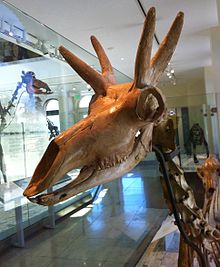
Ungulates are members of the diverse clade Euungulata, which primarily consists of large mammals with hooves. Once part of the clade "Ungulata" along with the clade Paenungulata, "Ungulata" has since been determined to be a polyphyletic and thereby invalid clade based on molecular data. As a result, true ungulates had since been reclassified to the newer clade Euungulata in 2001 within the clade Laurasiatheria while Paenungulata has been reclassified to a distant clade Afrotheria. Living ungulates are divided into two orders: Perissodactyla including equines, rhinoceroses, and tapirs; and Artiodactyla including cattle, antelope, pigs, giraffes, camels, sheep, deer, and hippopotamuses, among others. Cetaceans such as whales, dolphins, and porpoises are also classified as artiodactyls, although they do not have hooves. Most terrestrial ungulates use the hoofed tips of their toes to support their body weight while standing or moving. Two other orders of ungulates, Notoungulata and Litopterna, both native to South America, became extinct at the end of the Pleistocene, around 12,000 years ago.

Artiodactyls are placental mammals belonging to the order Artiodactyla. Typically, they are ungulates which bear weight equally on two of their five toes: the third and fourth, often in the form of a hoof. The other three toes are either present, absent, vestigial, or pointing posteriorly. By contrast, most perissodactyls bear weight on an odd number of the five toes. Another difference between the two is that many artiodactyls digest plant cellulose in one or more stomach chambers rather than in their intestine as perissodactyls do. The advent of molecular biology, along with new fossil discoveries, found that cetaceans fall within this taxonomic branch, being most closely related to hippopotamuses. Some modern taxonomists thus apply the name Cetartiodactyla to this group, while others opt to include cetaceans within the existing name of Artiodactyla. Some researchers use "even-toed ungulates" to exclude cetaceans and only include terrestrial artiodactyls, making the term paraphyletic in nature.

The subfamily Caprinae, also sometimes referred to as the tribe Caprini, is part of the ruminant family Bovidae, and consists of mostly medium-sized bovids. A member of this subfamily is called a caprine.

The Bovidae comprise the biological family of cloven-hoofed, ruminant mammals that includes cattle, yaks, bison, buffalo, antelopes, sheep and goats. A member of this family is called a bovid. With 143 extant species and 300 known extinct species, the family Bovidae consists of 11 major subfamilies and thirteen major tribes. The family evolved 20 million years ago, in the early Miocene.

The Giraffidae are a family of ruminant artiodactyl mammals that share a common ancestor with deer and bovids. This family, once a diverse group spread throughout Eurasia and Africa, presently comprises only two extant genera, the giraffe and the okapi. Both are confined to sub-Saharan Africa: the giraffe to the open savannas, and the okapi to the dense rainforest of the Congo. The two genera look very different on first sight, but share a number of common features, including a long, dark-coloured tongue, lobed canine teeth, and horns covered in skin, called ossicones.

Antilocapra is a genus of the family Antilocapridae, which contains only a single living species, the pronghorn (Antilocapra americana). Another species, the Pacific pronghorn, lived in California during the Late Pleistocene and survived as recently as 12,000 BP. The name means "antelope-goat".
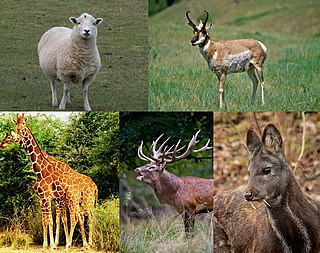
Pecora is an infraorder of even-toed hoofed mammals with ruminant digestion. Most members of Pecora have cranial appendages projecting from their frontal bones; only two extant genera lack them, Hydropotes and Moschus. The name "Pecora" comes from the Latin word pecus, which means "cattle". Although most pecorans have cranial appendages, only some of these are properly called "horns", and many scientists agree that these appendages did not arise from a common ancestor, but instead evolved independently on at least two occasions. Likewise, while Pecora as a group is supported by both molecular and morphological studies, morphological support for interrelationships between pecoran families is disputed.
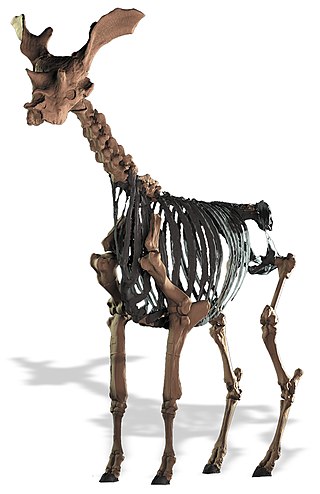
Sivatherium is an extinct genus of giraffids that ranged throughout Africa to the Indian subcontinent. The species Sivatherium giganteum is, by weight, one of the largest giraffids known, and also one of the largest ruminants of all time.
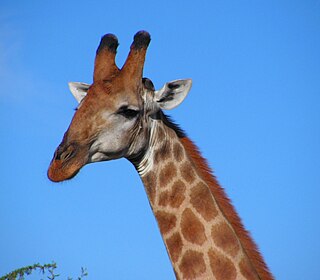
Ossicones are columnar or conical skin-covered bone structures on the heads of giraffes, male okapi, and some of their extinct relatives. Ossicones are distinguished from the superficially similar structures of horns and antlers by their unique development and a permanent covering of skin and fur.

Osbornoceros is an extinct artiodactyl genus of the family Antilocapridae. All antilocaprid species are extinct except for the pronghorn. Osbornoceros osborni is the only known species of the genus Osbornoceros. Osbornoceros lived during the Late Miocene around 7 to 6 million years ago in what is now North America. It is well represented in fossil discoveries, with nearly a dozen specimens having been found to date. All come from the Chamita Formation in a quarry near Lyden, New Mexico, the site of numerous other finds such as that of Chamitataxus, a prehistoric badger that lived at the same time. The holotype specimen of Osbornoceros was discovered in 1937 and many more were found nearby during further expeditions.
Hexameryx is an extinct monospecific genus of the artiodactyl family Antilocapridae endemic to North America. It lived during the Pliocene epoch 5.3—4.9 mya. It had six well-forked horns.

The Palaeomerycidae is an extinct family of Neogene ruminants belonging to the infraorder Pecora. Palaeomerycids lived in Europe and Asia exclusively during the Miocene, coevolving with cervids, bovids, moschids, and tragulids there as part of a dramatic radiation of ruminants by the early Miocene.
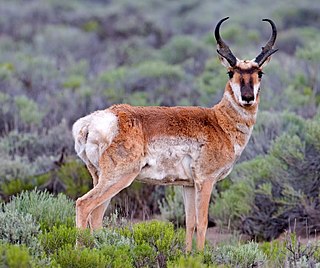
The pronghorn is a species of artiodactyl mammal indigenous to interior western and central North America. Though not an antelope, it is known colloquially in North America as the American antelope, prong buck, pronghorn antelope and prairie antelope, because it closely resembles the antelopes of the Old World and fills a similar ecological niche due to parallel evolution. It is the only surviving member of the family Antilocapridae.

Ramoceros is an extinct genus of the artiodactyl family Antilocapridae endemic to Middle Miocene (Clarendonian) North America.

Merycodus is an extinct genus of the artiodactyl family Antilocapridae. Fossils of this genus have been found in the Santa Fe Group of New Mexico.

Stockoceros is an extinct genus of the North American artiodactyl family Antilocapridae (pronghorns), known from what is now Mexico and the southwestern United States. The genus survived until about 12,000 years ago, and was present when Paleo-Indians reached North America.
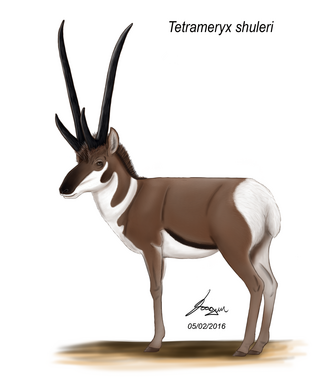
Tetrameryx is an extinct genus of the North American artiodactyl family Antilocapridae, known from Mexico, the western United States, and Saskatchewan in Canada.

Merriamoceros is an extinct genus of pronghorn. It is known from a single species, which is also the type species, M. coronatus.

Capromeryx was a genus of dwarf pronghorns (Antilocapridae) that originated in North America during the Pliocene about 5 million years ago. The closest living relative and only surviving member of the family is the North American pronghorn.




